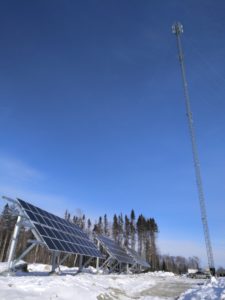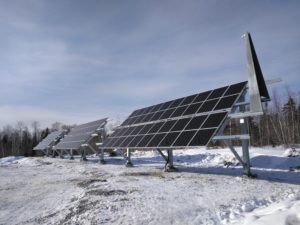Solar Energy Powers Remote Cell Towers

Projects Sponsor
Traditionally, Bell Canada’s remote telecommunications towers have run on diesel generators. Switching the primary power from diesel to solar panels and batteries significantly decreases diesel consumption and greenhouse gas emissions. A recent pilot project at Dorval Lodge in the centre of La Vérendrye Wildlife Reserve, aiming to reduce diesel consumption at remote cell sites by 40%, delivered beyond promising results. Diesel consumption at the site is plummeting by 75%, far surpassing expectations. Bell and partners took an urgent call on climate change and good news was on the line.
While Bell Canada’s 5G cellular service is currently accessible to more than 70% of Canadians, Bell aims to expand that coverage even further. Since that is a lot of communications infrastructure, the company is looking to gain a better understanding of how they can manage energy use more efficiently and optimise the way they connect cellular towers.
As well as the direct environmental consequences of building and operating their infrastructure, Bell understands that their network deployments in remote communities have many indirect impacts on the people who live there. Maintaining strong relationships with local communities and having the proper social licence to operate within them is crucial to their brand’s reputation.

Bell’s recent highly successful pilot project at Dorval Lodge, in the centre of environmentally-sensitive La Vérendrye Wildlife Reserve, has guided Bell as how to best incorporate and improve upon the technology they employ at other sites. The Quebec project focused on the need for cellular coverage in and around La Vérendrye Wildlife Reserve. To this end, Bell partnered with the University of Sherbrooke’s Interdisciplinary Institute for Technological Innovation (3IT) and its Nanotechnologies and Nanosystems Laboratory (LN2), as well as with Saint-Augustin Canada Electric Inc. (STACE). The team worked to develop solar-powered systems that reduce the need for diesel generators.
Using solar panels and batteries to power telecommunications significantly decreases diesel consumption and greenhouse gas emissions. The Dorval Lodge project aimed to reduce diesel consumption by a minimum of 40% – an ambitious target, but one that was surpassed. Working together, Bell and their partners found ways to reduce diesel consumption at remote sites by 75%. So far, the site has generated 16,000 kWh of renewable energy (saving 5,600 litres of diesel).
The photovoltaic bifacial modules, which produce power from the back as well as the front, performed well in the winter and seemed to clean snow more easily than the monofacial modules. While weather conditions are difficult to predict, temperature fluctuations are important. It is not rare to go from -30C to +30C between seasons for this site. The temperature of the batteries was higher than expected during the summer but was kept within an acceptable range. That system components redundancy is important for reliable operation in remote locations; Bell’s forward-thinking environmental mandate and operations gives them many chances to put that knowledge to use. This is hardly Bell’s only renewable project. They currently operate nine photovoltaic and diesel hybrid power systems in remote sites in the NWT. Their photovoltaic power systems in the NWT and Whitehorse, Yukon, generate approximately 130,000 kWh of renewable energy every year. Together saving approximately 27,000 litres of diesel, the equivalent of 73 tonnes of CO2 per year.

In Ontario, wind and solar power technologies installed at 12 remote cell sites have generated approximately 50,000 kWh of renewable energy a year, while in the Atlantic region, Bell’s solar arrays at 10 sites generated about 70,000 kWh. Using the technology developed for Dorval Lodge, Bell’s most recent Manitoba remote operation now performs even better than the pilot, consuming less than a tenth of the energy required at traditional sites. Bell is currently qualifying lithium battery vendors and technologies that are ideally suited for off-grid applications, efficient recharge and remote-monitoring capabilities. The batteries selected will be suitable for the grid-connected cellular network and off-the-grid sites.
All this research and investment unlock greater opportunities in creating a sustainable future, now a strategic imperative for the company.
Bell Canada took an urgent call on climate change and good news was on the line.













